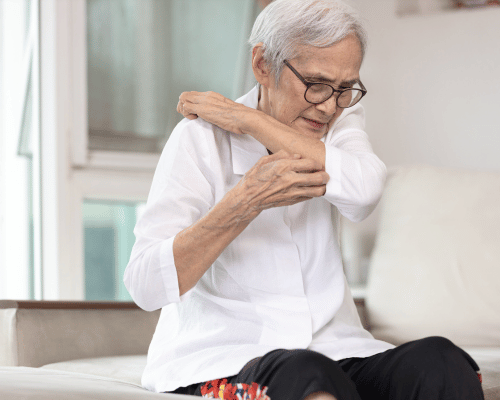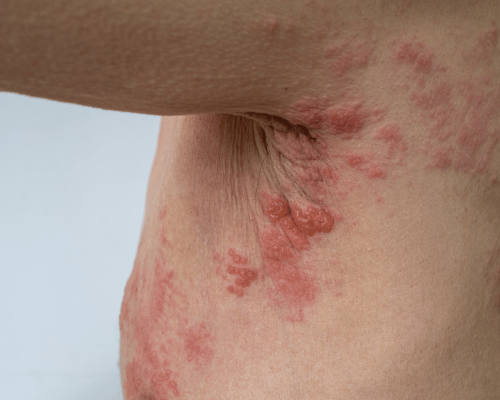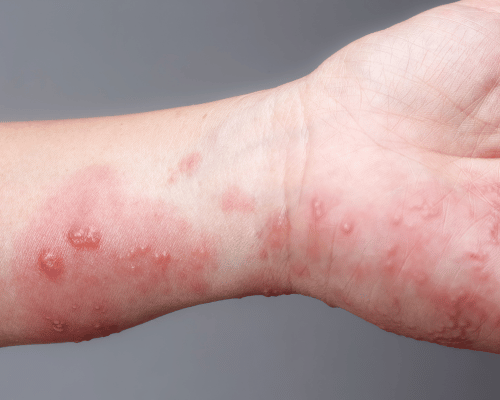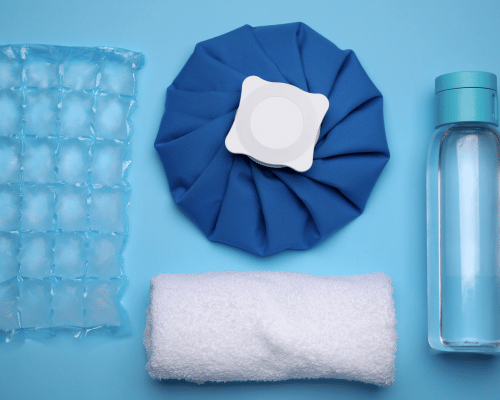As we journey through life, our bodies face numerous health challenges, one of which is shingles, or herpes zoster. This condition, emerging from the shadows of the varicella-zoster virus - the same culprit behind childhood chickenpox, often finds its way to us in our later years. It's a poignant reminder of our body's changing defenses; as we grow older, our immune system gradually loses its vigor, paving the way for this dormant virus to reawaken. Shingles doesn't just bring physical discomfort; it can be a source of concern and anxiety, especially in the elderly. Let's explore together what shingles means for our elderly loved ones and the vital signs to watch for, so we can offer them the care and support they deserve
As individuals age, the manifestations of certain diseases can differ from those in younger populations. Shingles, or herpes zoster, showcases such differential symptoms. Although many people associate shingles with its characteristic painful rash, older adults often grapple with additional challenges. Let's delve deeper into these unique symptoms that predominantly affect older individuals.
Postherpetic Neuralgia stands out as one of the most debilitating complications of shingles among older adults. While the initial rash causes discomfort, it's the lingering pain of PHN that often proves more challenging. This pain persists in the area previously occupied by the inflammation. Imagine a wound that has visually healed but continues to throb with pain. That's the ordeal many elderly individuals face with PHN. The pain can be sharp, burning, or even a constant ache, and it can disrupt sleep, affect mood, and reduce the quality of life. In some cases, this pain lingers for months, and unfortunately for some, it stretches into years.

Typically, shingles confine themselves to a specific part of the body, following the path of certain nerve routes. However, in some elderly patients, we observe a phenomenon called Disseminated Zoster. Rather than staying localized, the rash spreads, covering larger areas of the body. This widespread manifestation not only intensifies the discomfort but also increases the risk of complications. It's crucial to identify and treat Disseminated Zoster promptly to prevent further issues.
Shingles doesn't limit itself to the torso or limbs. In some instances, it targets facial nerves, particularly those around the eyes. When this happens, older adults are at a heightened risk of vision complications. The rash can cause inflammation and infections in the eye, leading to conditions like conjunctivitis, keratitis, or uveitis. If we overlook or inadequately treat these conditions, they can progress, culminating in permanent vision loss. Thus, any sign of shingles near the eyes necessitates immediate medical attention.
In conclusion, while shingles present challenges for individuals of all ages, older adults bear the brunt of its more severe symptoms. Recognizing these symptoms early on paves the way for timely treatment and better outcomes.
Prevention remains the most effective strategy, especially for older adults. The Shingles Vaccine is a critical tool in reducing the chances of developing the disease and its complications. As one grows older, ensuring up-to-date vaccinations becomes paramount. Regular check-ups and timely immunizations can play a pivotal role in shingles prevention.

Early recognition of shingles symptoms can significantly influence the trajectory of the disease, especially in elderly individuals. Given the more severe manifestations they might experience, identifying and acting upon these early signs becomes paramount.
One of the earliest indicators of shingles is an unusual sensitivity or pain in a particular part of the body. This discomfort can be deceptive, leading some to misattribute it to other conditions like heartburn, kidney stones, or even muscular pain. However, it's essential to note that this pain arises from the nerve roots affected by the varicella-zoster virus, the culprit behind shingles. If an elderly individual complains of such unexplained pain, especially if they have had chickenpox in the past, considering a shingles diagnosis could be prudent.
Another subtle sign of shingles is the onset of symptoms mimicking the flu but without the accompanying fever. Older adults might experience chills, a sense of fatigue, or even an upset stomach. These symptoms can easily be dismissed as a common cold or a minor viral infection. Still, in the context of the sensitivity as mentioned above or pain, they warrant further investigation.
As shingles begin their journey with older adults, they follow a relatively predictable path:
After the early signs, the next stage is the appearance of the rash. The affected area starts to exhibit redness and swelling. Within days, this escalates into the formation of clusters of blisters. These blisters are often filled with a clear fluid and can be pretty painful.

As days progress, these blisters start resembling chickenpox lesions. They mature, filling further with fluid, and might eventually burst, especially if subjected to friction. Once they burst, a crust begins to form over them, signaling the beginning of the healing phase. It's crucial during this period to keep the area clean to prevent secondary bacterial infections.
The final stage of shingles sees the crusts drying up and gradually falling off. Underneath, the skin might appear reddish initially but eventually heals completely. In younger individuals, this healing can be relatively swift. However, in elderly individuals, given their slower regenerative capacities, complete recovery might take up to a month or sometimes even longer.
In wrapping up, while shingles can be a daunting experience, especially for older adults, understanding its onset and progression can equip one with the knowledge to tackle it head-on. With timely detection and appropriate care, its impact can be significantly mitigated.
Supporting an elderly individual with shingles requires a combination of medical intervention and compassionate care. The discomfort and pain associated with shingles can be distressing, especially for older adults. Here's a detailed guide on how to offer optimal care and support:
Doctors often prescribe antiviral medications for shingles, aiming to reduce the severity and duration of the disease. Ensure that you give these medications to the elderly individual as recommended. Adhering to the prescribed schedule is vital, as timely administration can prevent complications, reduce pain, and expedite the healing process. Furthermore, pain relievers, whether over-the-counter or prescribed, can alleviate discomfort. Always consult a healthcare professional before introducing any new medication.

The burning sensation from shingles can be overwhelming. One effective way to soothe this burning feeling is by applying cool compresses to the affected area. Soak a cloth in cold water, wring out the excess, and place it gently on the rash. Remember to use a clean cloth each time and avoid pressing too hard. The cooling effect can offer significant relief, making the ordeal more bearable.
What an individual wears can have a direct impact on their comfort level when dealing with shingles. Tight clothing can irritate the rash and increase discomfort. Instead, opt for loose, breathable fabrics like cotton. These prevent unnecessary friction against the inflammation and allow the skin to breathe, promoting healing. Additionally, consider dressing the elderly individual in layers, making it easier to adjust their clothing based on their comfort.
Shingles blisters are vulnerable to secondary bacterial infections, which can complicate recovery. To prevent this, it's essential to maintain the cleanliness of the affected area. Gently cleanse the rash with mild soap and lukewarm water. Pat the area dry with a soft towel; avoid rubbing. Additionally, ensure the elderly individual's hands are clean, discouraging them from scratching the rash. If needed, trim their nails to prevent accidental rupturing of the blisters.
Shingles in older adults demand particular attention due to the increased risk of severe symptoms and complications. Awareness, timely intervention, and adequate care are essential. Being informed is the first step to ensuring the well-being of our elderly loved ones.

BrightStar® Home Care Conejo Valley proudly stands at the forefront of in-home skilled nursing care, thanks to our dedicated team of Registered Nurses (RNs), Licensed Practical Nurses (LPNs), and Licensed Vocational Nurses (LVNs). Our team commits to delivering the highest quality nursing care right to your doorstep.
Understanding the deep-seated desire of many individuals to remain in the familiar comforts of their homes, especially as they navigate health challenges, we've tailored our services to meet these specific needs. Whether for short-term recovery or long-term support, our professional nursing staff ensures that your loved one receives optimal care without needing to relocate to a healthcare facility.
Moreover, our wide array of services cater to more than just the well-being of the individual receiving care. We also recognize the concerns and anxieties of family members and caregivers. By choosing BrightStar® Home Care Conejo Valley, you're not just opting for superior healthcare for your loved one; you're also gifting yourself invaluable peace of mind, knowing they're in capable and compassionate hands.
BrightStar Care of Conejo Valley is here to provide you with the resources and support you need to take care of your loved one. Contact us through our website or at 805-233-3800 or visit us at 370 N. Westlake Blvd. Suite 120 Westlake Village, CA 91362, and speak with one of our experts who will help you get started. Thank you for taking the time to read this!
Delving Deeper: Symptoms Unique to the Elderly Population
As individuals age, the manifestations of certain diseases can differ from those in younger populations. Shingles, or herpes zoster, showcases such differential symptoms. Although many people associate shingles with its characteristic painful rash, older adults often grapple with additional challenges. Let's delve deeper into these unique symptoms that predominantly affect older individuals.
1. Postherpetic Neuralgia (PHN): The Lingering Pain
Postherpetic Neuralgia stands out as one of the most debilitating complications of shingles among older adults. While the initial rash causes discomfort, it's the lingering pain of PHN that often proves more challenging. This pain persists in the area previously occupied by the inflammation. Imagine a wound that has visually healed but continues to throb with pain. That's the ordeal many elderly individuals face with PHN. The pain can be sharp, burning, or even a constant ache, and it can disrupt sleep, affect mood, and reduce the quality of life. In some cases, this pain lingers for months, and unfortunately for some, it stretches into years.
2. Disseminated Zoster: Beyond Localized Boundaries
Typically, shingles confine themselves to a specific part of the body, following the path of certain nerve routes. However, in some elderly patients, we observe a phenomenon called Disseminated Zoster. Rather than staying localized, the rash spreads, covering larger areas of the body. This widespread manifestation not only intensifies the discomfort but also increases the risk of complications. It's crucial to identify and treat Disseminated Zoster promptly to prevent further issues.
3. Vision Complications: More Than Meets the Eye
Shingles doesn't limit itself to the torso or limbs. In some instances, it targets facial nerves, particularly those around the eyes. When this happens, older adults are at a heightened risk of vision complications. The rash can cause inflammation and infections in the eye, leading to conditions like conjunctivitis, keratitis, or uveitis. If we overlook or inadequately treat these conditions, they can progress, culminating in permanent vision loss. Thus, any sign of shingles near the eyes necessitates immediate medical attention.In conclusion, while shingles present challenges for individuals of all ages, older adults bear the brunt of its more severe symptoms. Recognizing these symptoms early on paves the way for timely treatment and better outcomes.
Prevention Is Better Than Cure
Prevention remains the most effective strategy, especially for older adults. The Shingles Vaccine is a critical tool in reducing the chances of developing the disease and its complications. As one grows older, ensuring up-to-date vaccinations becomes paramount. Regular check-ups and timely immunizations can play a pivotal role in shingles prevention.
Understanding the Onset and Progression of Shingles in the Elderly
Early recognition of shingles symptoms can significantly influence the trajectory of the disease, especially in elderly individuals. Given the more severe manifestations they might experience, identifying and acting upon these early signs becomes paramount.
1. Sensitivity or Pain in a Specific Area
One of the earliest indicators of shingles is an unusual sensitivity or pain in a particular part of the body. This discomfort can be deceptive, leading some to misattribute it to other conditions like heartburn, kidney stones, or even muscular pain. However, it's essential to note that this pain arises from the nerve roots affected by the varicella-zoster virus, the culprit behind shingles. If an elderly individual complains of such unexplained pain, especially if they have had chickenpox in the past, considering a shingles diagnosis could be prudent.
2. Flu-like Symptoms Sans Fever
Another subtle sign of shingles is the onset of symptoms mimicking the flu but without the accompanying fever. Older adults might experience chills, a sense of fatigue, or even an upset stomach. These symptoms can easily be dismissed as a common cold or a minor viral infection. Still, in the context of the sensitivity as mentioned above or pain, they warrant further investigation.
Unraveling the Stages of Shingles
As shingles begin their journey with older adults, they follow a relatively predictable path:
1. The Emergence of the Initial Rash
After the early signs, the next stage is the appearance of the rash. The affected area starts to exhibit redness and swelling. Within days, this escalates into the formation of clusters of blisters. These blisters are often filled with a clear fluid and can be pretty painful.
2. The Evolution of the Rash
As days progress, these blisters start resembling chickenpox lesions. They mature, filling further with fluid, and might eventually burst, especially if subjected to friction. Once they burst, a crust begins to form over them, signaling the beginning of the healing phase. It's crucial during this period to keep the area clean to prevent secondary bacterial infections.
3. The Healing Process
The final stage of shingles sees the crusts drying up and gradually falling off. Underneath, the skin might appear reddish initially but eventually heals completely. In younger individuals, this healing can be relatively swift. However, in elderly individuals, given their slower regenerative capacities, complete recovery might take up to a month or sometimes even longer.In wrapping up, while shingles can be a daunting experience, especially for older adults, understanding its onset and progression can equip one with the knowledge to tackle it head-on. With timely detection and appropriate care, its impact can be significantly mitigated.
Guidelines for Assisting an Elderly Loved One with Shingles
Supporting an elderly individual with shingles requires a combination of medical intervention and compassionate care. The discomfort and pain associated with shingles can be distressing, especially for older adults. Here's a detailed guide on how to offer optimal care and support:
1. Timely Administration of Prescribed Medication
Doctors often prescribe antiviral medications for shingles, aiming to reduce the severity and duration of the disease. Ensure that you give these medications to the elderly individual as recommended. Adhering to the prescribed schedule is vital, as timely administration can prevent complications, reduce pain, and expedite the healing process. Furthermore, pain relievers, whether over-the-counter or prescribed, can alleviate discomfort. Always consult a healthcare professional before introducing any new medication.
2. Offering Relief with Cool Compresses
The burning sensation from shingles can be overwhelming. One effective way to soothe this burning feeling is by applying cool compresses to the affected area. Soak a cloth in cold water, wring out the excess, and place it gently on the rash. Remember to use a clean cloth each time and avoid pressing too hard. The cooling effect can offer significant relief, making the ordeal more bearable.
3. Choosing the Right Clothing
What an individual wears can have a direct impact on their comfort level when dealing with shingles. Tight clothing can irritate the rash and increase discomfort. Instead, opt for loose, breathable fabrics like cotton. These prevent unnecessary friction against the inflammation and allow the skin to breathe, promoting healing. Additionally, consider dressing the elderly individual in layers, making it easier to adjust their clothing based on their comfort.
4. Emphasizing Cleanliness and Hygiene
Shingles blisters are vulnerable to secondary bacterial infections, which can complicate recovery. To prevent this, it's essential to maintain the cleanliness of the affected area. Gently cleanse the rash with mild soap and lukewarm water. Pat the area dry with a soft towel; avoid rubbing. Additionally, ensure the elderly individual's hands are clean, discouraging them from scratching the rash. If needed, trim their nails to prevent accidental rupturing of the blisters.Shingles in older adults demand particular attention due to the increased risk of severe symptoms and complications. Awareness, timely intervention, and adequate care are essential. Being informed is the first step to ensuring the well-being of our elderly loved ones.

Skilled Nursing Care at Your Doorstep with BrightStar® Home Care Conejo Valley
BrightStar® Home Care Conejo Valley proudly stands at the forefront of in-home skilled nursing care, thanks to our dedicated team of Registered Nurses (RNs), Licensed Practical Nurses (LPNs), and Licensed Vocational Nurses (LVNs). Our team commits to delivering the highest quality nursing care right to your doorstep.Understanding the deep-seated desire of many individuals to remain in the familiar comforts of their homes, especially as they navigate health challenges, we've tailored our services to meet these specific needs. Whether for short-term recovery or long-term support, our professional nursing staff ensures that your loved one receives optimal care without needing to relocate to a healthcare facility.
Moreover, our wide array of services cater to more than just the well-being of the individual receiving care. We also recognize the concerns and anxieties of family members and caregivers. By choosing BrightStar® Home Care Conejo Valley, you're not just opting for superior healthcare for your loved one; you're also gifting yourself invaluable peace of mind, knowing they're in capable and compassionate hands.
